Lives Worth Living
[DVD]
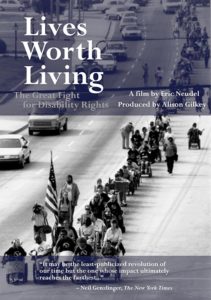
view/request
When I went to the Northampton Senior Center for a special Northampton Commission on Disability screening of Lives Worth Living I didn’t know anything about the film or its subject the disability rights movements. I was pleasantly surprised to find that the film was not just informative, but a well-crafted and incredibly moving introduction to the subject that left me eager to learn more.
At just 54 minutes in length, Lives Worth Living is too short to be more than an introduction to the story of disability rights (which it traces from the polio epidemics of the early twentieth century and the treatment of disabled veterans up to the passage of the Americans With Disabilities Act of 1990), but it makes excellent use of the time it has. We briefly learn about the discrimination and negative attitudes faced by the people with disabilities who were too often assumed to be without potential or worth. We briefly learn about the shocking maltreatment of people with mental disorders and about the Willowbrook State School and the abuses that occurred there and at similar institutions throughout the country. We learn about the Architectural Barriers Act of 1968, the Rehabilitation Act of 1973, and other early legislation, but more importantly we learn about the advocates who pushed to expand protections for the disabled, unifying diverse groups (associations for the blind, the physically handicapped, mental patients and others), and how disability rights became recognized as civil rights. And we learn about the protesters—the individuals who occupied buildings, locked themselves to bus shelters, and even crawled and pulled their way up the capitol steps to make their message heard.
Lives Worth Moving is a powerful film, well worth watching and relevant to us all. I cannot recommend it enough.
Reviewed by Ben
Tagged: Civil rights, Disability, Documentary, Film, History
Show Me the Magic
by Paul Mazursky
[Book]
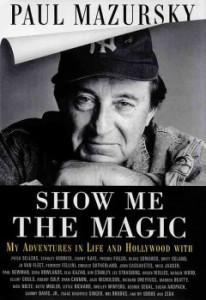
view/request
riter/director/producer/actor Paul Mazursky’s autobiography is an anecdotal collection of Hollywood tales, international adventures and reflections on growing up in Brooklyn. A real page turner, too! I ignored those around me and read this cover to cover in two evenings. Mazursky, who directed classics such as Bob and Carol and Ted and Alice, Blume in Love, Tempest, Moscow on the Hudson and An Unmarried Woman, has plenty of interesting tales to share.
The author recalls showbiz run-ins with Stanley Kubrick (Mazursky’s first major acting role was in Kubrick’s Fear and Desire), Orson Welles, Peter Sellers, George Segal, John Cassavetes, Gena Rowlands, Warren Beatty and Natalie Wood among others. What’s possibly the most fascinating is his relationship with Federico Fellini. It’s a touching friendship and their meeting is something of legend. In addition, Mazursky includes several letters from the great Italian film director in his book.
The title “Show Me the Magic” comes from one of the most exciting pieces of cinema history; a piece of dialog from Mazursky’s adaptation of Shakespeare’s The Tempest. Forever imprinted in my mind is the scene where John Cassavetes conjures up a small miracle… in a film that plays it straight up until that point. An unpredictable moment on screen and perfectly fitting coming the mind of a man who lived an exciting and unpredictable life.
Reviewed by Jason
Tagged: Film, Memoir, Non-fiction
Waking Sleeping Beauty
[DVD]
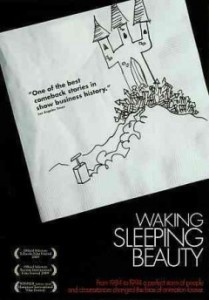
view/request
In Waking Sleeping Beauty, we go behind the doors of the Disney animation building and see an equal display of creative brilliance and management melodrama. As the 1970’s drew to a close, the legendary animation studio was producing anemic box office returns (by Disney standards) and those in charge of the purse strings viewed its limping continuation simply as a tribute to Walt’s legacy. Shifts in corporate leadership created new challenges to the once easy going, hippie-ish department and as a result, the company reached a range of highs and lows.
This film features interviews with animators, directors, composers and executives. In addition, the curtain is lifted and we’re granted access to all sorts of behind the scenes footage. We see the animators at work and goofing around, early film cuts and cells, actors recording voice-overs, corporate lectures, between take banter of Michael Eisner’s television introductions and even funeral speeches. Waking Sleeping Beauty is a film for anyone who is interested in the history of the Disney empire and ever wondered how the magic is really created.
Reviewed by Jason
Tagged: Animation, Disney, Documentary, Film
Trippin’ with Terry Southern
by Gail Gerber with Tom Lisanti
[Book]

view/request
Gail Gerber’s memoir recalls her time spent with the famous novelist and screenwriter Terry Southern (Dr. Strangelove, the Magic Christian, Blue Movie, Candy, etc.). Despite the title, the book is not filled with madcap, drug taking adventures. Rather, we see an intimate portrait of a couple’s life together through a thirty year period. It also focuses on Southern’s idiosyncrasies, humor and career highs and lows.
Gerber, a stage actress and ballet dancer, also shares several of her professional and personal experiences ranging from early 60’s appearances in Beach Ball, The Loved One and a couple of Elvis Presley films to life as a casual farmer.
Trippin’ with Terry Southern is an interesting memoir and is certainly essential read for Southern fans. In addition, those who enjoy reading about 1960’s and 70’s escapades will be really enjoy the memoir… just peak at the back index to see a list of all of the exciting characters who will pop up (there’s Dennis Hopper, Rip Torn and Stanley Kubrick just to name a few)!
Reviewed by Jason
Tagged: Biography, Film, Memoir, Non-fiction
Let’s Spend the Night Together
by Hal Ashby
[DVD]

view/request
I remember watching the Rolling Stones in Let’s Spend the Night Together a few times on television when I was in high school. I know this sounds unbelievable, but VH1 used to show concert films and was actually a music station back in the day. Maybe I couldn’t get behind the 1981 renditions of the classic 60’s tunes at the time or was distracted by Mick Jagger’s football tights … truth is, I didn’t really dig the concert film when I first watched it.
Fast forward to last night. I popped in this dvd for nostalgia sake and wound up really enjoying myself. The performances are unbelievable! In addition, I made the statement to my friend who was sitting next to me on the sofa that “this just might be the best Stones concert film ever.”
The boys barrel through 24 songs in under 90 minutes with the right blend of machismo and camp that we expect from the band. Despite playing a huge stadium, they’re very, very loose with unexpected bendy guitar riffs distributed throughout by Ron and Keith , jazzy drum fills care of Mr. Watts and Mick’s wild singing. If you look close enough, you may even see a smile on Bill Wyman’s face, too. Some of the older songs appear to be unrehearsed to a certain extent while more recent cuts from Tattoo You, Emotional Rescue and Some Girls are played tight like a classic rhythm and blues review. We’re also treated to a bonus keyboard section featuring Ian McLagan (of the Small Faces & Faces fame) sitting behind the organ and classic stones session man Ian Stewart on piano.
It’s also important to note that a serious filmmaker was on staff for Let’s Spend the Night Together. Hal Ashby, whose credits include Harold & Maude, The Last Detail, Being There and many other fantastic titles, directed the film. It’s always interesting to see the difference between a standard concert film and one that was overseen by a true artist. Martin Scorsese’s work on the Last Waltz and D.A. Pennebaker’s Montery Pop are other excellent examples. They tend to spend more time with the performers and not make pointless quick cuts. There is something to be said in what these filmmakers find interesting and insist the audience see on stage.
The real lesson learned however is that it doesn’t hurt to revisit films you may not have enjoyed at one stage in your life. You never know in what direction your taste may take you.
Reviewed by Jason
Tagged: Classic rock, Concert film, Film, Live recordings, Rock music
Last Train Home
[DVD]
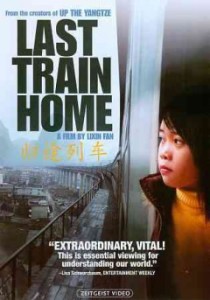
view/request
There are 130 million migrant workers in China, many of whom only journey home to see their families once a year on Chinese New Year. Lixin Fan’s 2009 award winning documentary follows the journey, conflict and struggle of one such family and is a film of remarkable impact. To its western audiences, the film is an eye opening look into the arduous lives of the thousands of low wage workers who produce assemble and manufacture many of our imported goods. While the film exposes the insidious impact of globalization and the poor working conditions of Chinese low wage workers, it is equally successful in capturing universal family conflicts and generational differences. The ‘mass exodus’ of Chinese workers home for the Spring Festival is the world’s largest human migration. The arduous journey of the Zhang family from their urban factory and cramped living conditions back to their poor rural village vividly illustrates the dramatic changes Chinese society has undergone as a result of its economic role in the global marketplace. The film is shot in a cinema-verite, fly on the wall style and the viewer is confronted not only by our role and responsibility as the world’s largest consumers, but by our perspective as the viewer of this hauntingly intimate look into the lives of this family. The parents of the family have sacrificed being present to raise their children for the purpose of sending enough money home to allow their children to pursue their education and have a better life than they have. When their rebellious teenage daughter confronts them about their continual absence and the pressure they place on her to succeed, she addresses the camera directly and the viewer can’t help but feel connected to this extraordinarily personal, politically relevant and remarkably timely film.
Reviewed by Dylan
Tagged: China, Documentary, Film
Henning Goes to the Movies
by Henning Ohlenbusch
[Music CD]
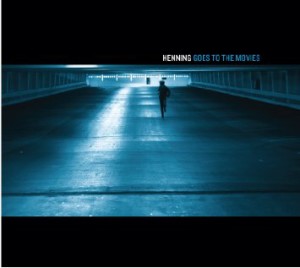
view/request
Please excuse the following burst of textual immodesty… Ahem. As founder and president (not to mention CEO, secretary, vice president & mascot) of the Forbes Film Club, I can safely say that I know a thing or two about the cinema. In addition, it was in college where I studied video and film, wrote lengthy ramblings dealing with issues within the worlds of documentary film and German cinema, composed pretentious screenplays and starred in some student produced shorts that feature poor lighting (often typecast as a chat show host, bud did sport a tricorne hat once for a period piece). I later found myself in Texas working in a video library/archive and spent most evenings devouring the collection and attending curated film festivals. To this day, little gives me greater pleasure than sitting in the theater, munching on popcorn and seeing something unfold on the big screen.
I have very personal connections to a handful of films and I believe movies we love can have a great impact on how we define ourselves. This is why Henning Goes to the Movies is so appealing.
Nine movies. Nine songs. Henning Ohlenbusch, lyricist extraordinaire/singer/songwriter of the group School For the Dead, is the architect (perhaps I should use director in this instance?) behind this wonderful album. He sings about the hilariously raunchy Super Bad, David Lynch’s quiet drama the Straight Story, the horror classic Poltergeist, the coming of age classic the Year My Voice Broke and more. His approach to these pieces is not a highlight of important plot points; rather he shares his personal experience with each film. Through introducing a specific character’s perspective or providing an overall sentiment of a movie, Ohlenbusch invites the listener to go on a cinematic journey.
His folksy pop songs are simply arranged to bring us close to the stories. He also tastefully sets the scene with appropriate backing. We find ourselves somewhere in the distant future in Logan’s Run with weaving backward electric guitar and at an old time carnival in Joe Vs. the Volcano. Though voice and acoustic guitar tend to be in the forefront throughout, keyboards, glockenspiel, subtle effects, electric bass, harmony vocals and percussion expand the mix.
This a great collection of songs, even without the movie theme. And I should mention that you really don’t need to have seen the films to appreciate the record. It is, however, even more of a gratifying listen for those of us who find that films are an important fabric of our lives.
Reviewed by Jason
Tagged: Film, Folk music, Pop music, Rock music







